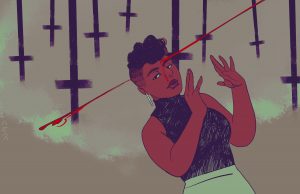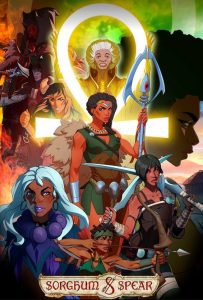An essay by Dr. Thomas Ain, as provided by Matthew R. Davis
Art provided by Errow Collins
My friends, I have been called before you tonight in order that I might bring you something that has been sorely lacking in recent days, and that thing is … hope.
Here, then, is a story we all know, and yet must never forget. Here is the story of the greatest human being ever to walk our humble Earth.
Now:
Jacinta Crowne was born in Sydney on the far cusp of the summer solstice, on what was then known as Christmas Day. Her parents surely regarded this as the greatest of all gifts, but over the years, Jacinta herself–lumbered with the initials JC–would come to resent the poor timing of this particular miracle. And maybe that was the catalyst for what was to come; maybe that’s what made it inevitable from the very first.
Jacinta’s parents were themselves regarded as giants in their respective fields of mathematics and philosophy, and were duly thrilled when their little girl quickly proved to be a prodigy beyond even their wildest dreams–by the age of five, she was conversant in three languages at a high school level, and performed flawless Bach recitals on piano when bored of study. Young Jacinta–often called Sin by friends and family, though they couldn’t have foreseen the irony in it–was encouraged and supported above all else, and that dedicated love paid exponential dividends. At the age of ten, she began parallel college courses to follow the forking paths of her parents; by the time she was fourteen, she had not only excelled, but broken new ground in every endeavour to which she turned her hand. The eyes of the world, always looking for new novelties and miracles, were soon upon her.
But with unmitigated brilliance, of course, came controversy.
Jacinta became the youngest person ever to be awarded the Norbert Wiener Prize in Applied Mathematics, but in the same year, she also shocked the art world by picking up the Dobell Prize with a pencil piece she claimed to have doodled whilst thinking on a bigger problem: “Erection Conjecture,” a series of tiny Goldbach numbers that resolved into a rather risqué nude portrait of Dr. Brian Cox. In a subsequent Rolling Stone interview, fifteen-year-old Jacinta referred to a number of scientific figureheads as “microcephalic apostates,” suggesting that they strap on some gloves and get in the ring with her if they took issue with this assessment. The only genius inflamed enough to take her up on this offer, Waldo “The Howling Bear” Kaczmarczyk, went down in the second round. At an age when her contemporaries were unable to name a single cogent ambition other than sleeping in as much as possible, Jacinta was proving to be such a prolific polymath that people began to wonder if she ever slept at all.
And so onward and upward she went, her intellectual ascent unchecked, even if her social skills were somewhat less developed. Jacinta spent so much time tackling intellectual disciplines that she had little idea how to relate to people outside these somewhat lofty realms. This was a weakness that her fellow students would target when they felt she needed a healthy dose of humble pie … and on her sixteenth birthday, shortly before she graduated from university with a superstring of honours, they exploited this weakness with a heady amount of Jägermeister. According to her erstwhile friends, this caused an extraordinary sequence of rash and uncharacteristic behaviours that caused her to be rechristened as Fish Fingers. And if there was some doubt cast on the veracity of that tale, then surely it is fair; this incident was not mentioned in any of the early biographies other than Maelina Dawn’s rather salacious JC & Me: The Story of a Girl Called Sin, which was full of enough inaccuracies that it was regarded as fraudulent fiction by the public at large.
But popularity was never foremost in Jacinta’s thoughts–only truth. Knowledge was power, and though she never longed for control over others, she found herself increasingly influential with every breakthrough. As soon as she left university–and before she could legally drink the Jäger that she’d already sworn off–Jacinta was snapped up by a series of well-funded think-tanks that quickly came to rely upon her incredibly refined brain. With her personal successes came showers of scientific regard, matched only by the torrential downpour of cash and blank-cheque grants. The world’s finest minds fell over each other in the mad scramble to work with her, and any postulated project that passed her lips was greenlit, funded, and staffed faster than light itself.

Amazed, we watched Jacinta coldly forgive her would-be assassin as he was dragged away, before turning to a fellow scientist and cracking a joke that had top-level physicists–and no-one else–howling for days. We all saw, and we all believed.
To read the rest of this story, check out the Mad Scientist Journal: Autumn 2018 collection.
Dr. Thomas Ain is an in-demand lecturer in post-modern theology, tenured at the University of South Australia. He won a Kyoto Prize in Arts and Philosophy in 2019 for his book The Lonely Gods: Jacinta Crowne and the New Archetypes of Humanity. His third wife is experimental visual artist HERA; they have no children of their own, but sponsor orphans in need the world over. When he gets a spare moment, Thomas likes to play chess against an AI gifted to him by the university or jam along on his ’65 Strat to Pink Floyd records … badly.
Matthew R. Davis is an author and musician based in Adelaide, South Australia, with an ever-growing number of short story publications to his name. He’s an Aurealis Awards judge for 2016 and 2017 and his own work has been noted by the Australian Shadows Awards. When not writing, he can be found playing bass and singing in alternative metal bands like icecocoon and Blood Red Renaissance, and he’s also in a happy relationship with a red-headed photographer and her cat. Find out more at matthewrdavisfiction.wordpress.com.
Errow is a comic artist and illustrator with a predilection towards mashing the surreal with the familiar. They pay their time to developing worlds not quite like our own with their fiancee and pushing the queer agenda. They probably left a candle burning somewhere. More of their work can be found at errowcollins.wix.com/portfolio.
“The Girl Who Killed Gods” is © 2018 Matthew R. Davis
Art accompanying story is © 2018 Errow Collins




 Bones and Bourbon
Bones and Bourbon If you’re in the Seattle area and would like to get your hands on some of our books, stop by the
If you’re in the Seattle area and would like to get your hands on some of our books, stop by the 